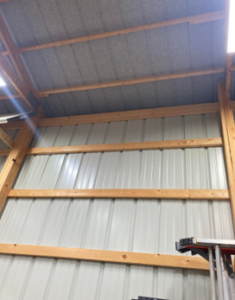Converting an Unfinished Wood Frame Steel Building
Reader GEOFF in WILLISTON writes:
 “ Mike, I think I came across a response on the internet of yours to a question about installing liner panels on the bottom chord of trusses and blowing insulation over the top. If memory serves me the question included the position of the vapor barrier on the liner side of the insulation. You had also recommended 2″ of spray foam on the underside of the roof panels to control condensation. My customer is converting an unfinished wood framed metal building into an equipment wash bay. I’m recommending spray foam on walls with liner panels over and liner panels affixed to the bottom cord of the trusses above. Do you think a vapor barrier on the bottom chords before liner panels, then blown insulation and spray foam on the underside of roof panels, and some power venting of the “attic” space should be about as effective as can reasonably be expected? (Trusses at 6′ O.C. with some supported added between.) “
“ Mike, I think I came across a response on the internet of yours to a question about installing liner panels on the bottom chord of trusses and blowing insulation over the top. If memory serves me the question included the position of the vapor barrier on the liner side of the insulation. You had also recommended 2″ of spray foam on the underside of the roof panels to control condensation. My customer is converting an unfinished wood framed metal building into an equipment wash bay. I’m recommending spray foam on walls with liner panels over and liner panels affixed to the bottom cord of the trusses above. Do you think a vapor barrier on the bottom chords before liner panels, then blown insulation and spray foam on the underside of roof panels, and some power venting of the “attic” space should be about as effective as can reasonably be expected? (Trusses at 6′ O.C. with some supported added between.) “
I tend to agree with building scientist and founding principal of Building Science Corporation Joe Lstiburek.
Joe stated, “Plastic vapor barriers should only be installed in vented attics in climates with more than 8,000 heating degree days.”
Read more on degree days here: https://www.hansenpolebuildings.com/2022/11/what-is-degree-day/
| What is Degree Day? – Hansen Buildings
According to Joe Lstiburek, “Plastic vapor barriers should only be installed in vented attics in climates with more than 8,000 heating degree days.” www.hansenpolebuildings.com |
In our climate, I would only install a ceiling vapor barrier above steel liner panels if I was intending to use blown cellulose for attic insulation. This is due to chemicals added to cellulose to prevent combustion tend to degrade steel if moisture is present. I would much rather see blown in granulated rockwool (my first choice) or fiberglass.
Attic ventilation is going to be critical here and is best resolved with adequate eave and ridge vents, rather than trying to be reliant upon an exhaust fan or fans.






